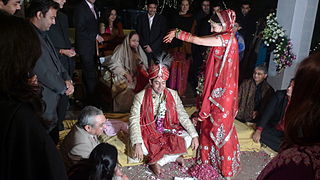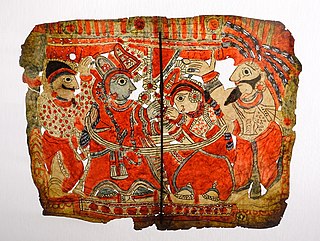Related Research Articles

A wedding is a ceremony where two people are united in marriage. Wedding traditions and customs vary greatly between cultures, ethnic groups, religions, countries, and social classes. Most wedding ceremonies involve an exchange of marriage vows by a couple, presentation of a gift, and a public proclamation of marriage by an authority figure or celebrant. Special wedding garments are often worn, and the ceremony is sometimes followed by a wedding reception. Music, poetry, prayers, or readings from religious texts or literature are also commonly incorporated into the ceremony, as well as superstitious customs originating in Ancient Rome.
A white wedding is a traditional formal or semi-formal wedding originating in Great Britain.

Mehndi is a form of body art originating in ancient India, in which decorative designs are created on a person's body, using a paste, created from the powdered dry leaves of the henna plant. Dating back to ancient India, mehndi is still a popular form of body art among the women of the Indian subcontinent, Bangladesh, Pakistan, Africa and the Middle East.
Blood Wedding is a tragedy by Spanish dramatist Federico García Lorca. It was written in 1932 and first performed at Teatro Beatriz in Madrid in March 1933, then later that year in Buenos Aires, Argentina. Theatre critics often group Blood Wedding with Lorca's Yerma and The House of Bernarda Alba as the "rural trilogy". Lorca's planned "trilogy of the Spanish earth" remained unfinished at the time of his death, as he did not include The House of Bernarda Alba in this group of works.

Traditional Chinese marriage is a ceremonial ritual within Chinese societies that involves a union between spouses, sometimes established by pre-arrangement between families. Within Chinese culture, romantic love and monogamy was the norm for most citizens.

Bride kidnapping, also known as bridenapping, marriage by abduction or marriage by capture, is a practice in which a man abducts the woman he wishes to marry. The woman is enslaved by her abductor, raped and taken as his wife. Later she may suffer different types of violence.

A Hindu wedding is Vivaha and the wedding ceremony is called Vivaah Sanskar in North India and Kalyanam (generally) in Tamil Nadu and Kerala. The wedding ceremonies are very colourful, and celebrations may extend for several days. The bride's and groom's home—entrance, doors, wall, floor, roof—are sometimes decorated with colors, balloons, and other decorations.

Hindu marriage harmonizes two individuals for ultimate eternity, so that they can pursue dharma (Truth), arth (meaning), and kama. It is a union of two individuals as spouses, and is recognized by liveable continuity. In Hinduism, marriage is followed by traditional rituals for consummation. In fact, marriage is not considered complete or valid until consummation. It also joins two families together. Favorable colours are normally red and gold for this occasion.

Gaye holud is a ceremony observed mostly in the Bengal region of the Indian subcontinent. It is part of an elaborate series of celebrations constituting the Bengali wedding. It originates from the Hindu wedding religious ceremony where Lord Shiva and his bride Sati were applied with Haldi to cool the couple and make them look even more beautiful. Later adopted in the Indian subcontinent as a wedding ritual and celebration by different communities, it continued in different religions down generations. The gaye holud takes place one or two days prior to the religious and legal Bengali wedding ceremonies. The gaye holud may be a joint event for the bride and groom's families, or it may consist of separate events for the bride's family and the groom's family.

Vivāha (Sanskrit) or Vivaah is marriage as it is practiced by Hindus in the Indian subcontinent. The word vivāha originated as a sacred union of people as per Vedic traditions, i.e. what many call marriage, but based on cosmic laws and advanced ancient practices. Under Vedic Hindu traditions, marriage is viewed as one of the saṁskāras, which are lifelong commitments of one wife and one husband. In India, marriage has been looked upon as having been designed by the cosmos and considered as a "sacred oneness witnessed by fire itself." Hindu families are patrilocal.

A varmala or jaimala is an Indian wedding garland symbolic of the popular marriage ceremony. Following regional traditions, the varmala might be made of rose flowers and/or other ceremonial stuff decorating it. The additives range from Rupee notes to other flowers to other family based traditions.
Punjabi wedding traditions are a strong reflection of Punjabi culture with ritual, song, dance, food, and dress that have evolved over centuries.

Bengali Hindu wedding refers to Bengali wedding with Hindu rites and rituals native to the Indian subcontinent.
Weddings in the United States follow traditions often based on religion, culture, and social norms. Most wedding traditions in the United States were assimilated from other, generally European, countries. Marriages in the U.S. are typically arranged by the participants and ceremonies may either be religious or civil. There was a tradition that the prospective bridegroom ask his future father-in-law for his blessing, but this is rarely observed today. When it is the first wedding for the bride, a typical U.S. wedding tends to be more elaborate.
An Odia Hindu wedding, or bahaghara, is a wedding ceremony performed by Odia Hindu people in the Indian state of Odisha. There are subtle differences in the rites observed by different castes. In Odia marriage rituals the mother of the bridegroom does not take part in the ceremony. The Utkala Brahmins have their weddings only in the daytime, preferably at midday or in the morning, while the other caste weddings are done during the evening or night. There is the custom of sending betel nuts to family friends for inviting them to the marriage. The first invitation is sent to the family deity as a respect to the lord. Marriages in Odisha are mostly fixed and arranged by the parents. Marriages for serving or capturing is not common. In the Odia community widow remarriage is allowed in some lower caste, in this case the younger brother is allowed to marry the deceased brother's wife. The marriage happens in three major rituals, Nirbandha, Bahaghara (wedding) and Chauthi/Chaturthi (consummation). A marriage is not considered complete or valid until consummation. These rituals are performed either at the Duara or Tola kanias house..

Traditional Hajong marriage is a ceremonial ritual that involves a marriage established by pre-arrangement between families. Within Hajong culture, romantic love and widow re-marriage was allowed, and monogamy was the norm for the Hajong people.
Harana may refer to:
Wedding customs in Ethiopia vary among the diverse tribes of that country and are among the most important expressions of each tribe's culture.
Brahma marriage defined in Manu Smriti
References
- ↑ Baṅkimacandra Caṭṭopādhyāẏa, Alo Shome Krishna Charitra Page 72 93813848782011 "(Harana is capturing a girl to marry her. A Rakshasa wedding is a wedding where the groom captures the bride by harana). "
| This Hinduism-related article is a stub. You can help Wikipedia by expanding it. |